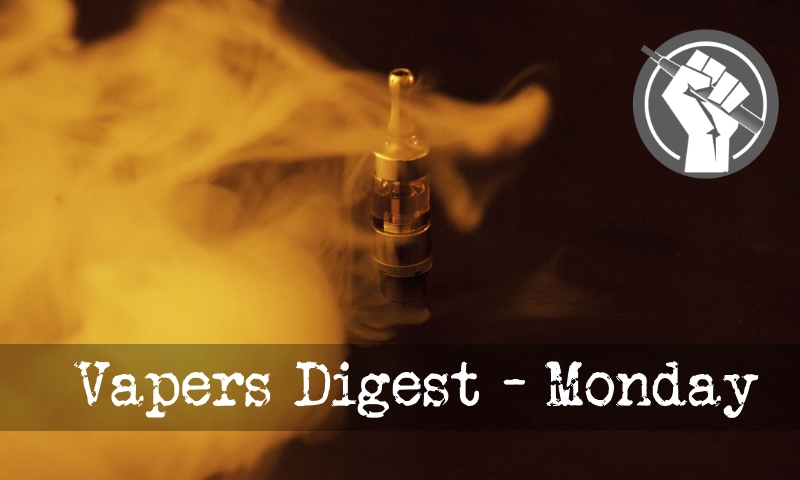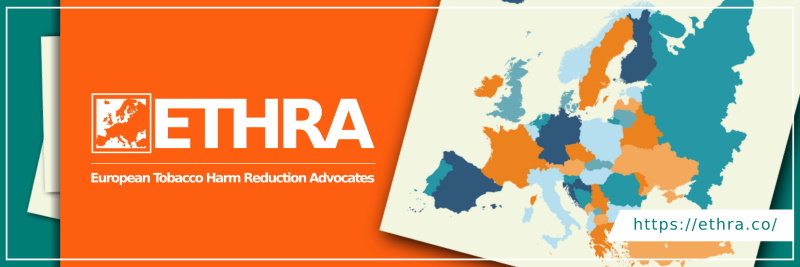Vapers Digest 31st October

Monday’s News at a glance:
The FDA’s Menthol Vape Ban Shows It Is Not a Science-Based Agency – Call to ban nicotine pouch sale to under-18s – FDA regulation has preserved and protected – Youth Tobacco And Vapor Product Use Declines In Washington – Vape-Click’s Legal Vape List – Czech Government Plea – How the switch to healthier nicotine products – Food and Chemicals Unpacked: Blowing Smoke: – Could the misinformation about the EVALI Outbreak be undone? – Group to gov’t: Back tobacco alternatives – How to enjoy nicotine – No, Prop. 31 isn’t really about protecting ‘the children’
The FDA’s Menthol Vape Ban
Shows It Is Not a Science-Based Agency – Martin Cullip
On October 26, the Food and Drug Administration (FDA) issued its first market denial orders for menthol vaping products. Its justification for the decision was “the application does not demonstrate that these menthol-flavored e-cigarettes are more effective in promoting complete switching or significant cigarette use reduction relative to tobacco-flavored e-cigarettes among adult smokers.”
This is yet another surprise sprung on manufacturers who believed that the FDA would make decisions based on science rather than moral panic and political disquiet. When businesses applied for authorization for their products, there was no indication that the FDA required non-tobacco flavors to be more efficacious than tobacco flavor for helping adult smokers quit.
Call to ban nicotine pouch sale to U-18s
Bella McShane – BBC News
Health campaigners are calling for a loophole to be closed that allows a nicotine product to be sold over the counter and online to under-18s.
Nicotine pouches – small parcels of nicotine that fit under the lip – are sold in most UK supermarkets.
But while the sale of cigarettes and e-cigarettes is forbidden to under-18s, pouches are not regulated in the same way.
Action on Smoking and Health (Ash) says the lack of rules is a “Wild West”. Nicotine pouches are not regulated under rules that cover tobacco or vaping products, or as a medical product.
FDA regulation has preserved…
And protected the most dangerous form of nicotine use
Michelle Minton – Reason
These comments were presented before an expert panel organized by the Reagan-Udall Foundation. This expert panel was convened as part of the Reagan-Udall Foundation’s operational evaluation of the U.S. Food and Drug Administration’s (FDA) Center for Tobacco Products.
I want to thank the expert panelists for including this public dialogue as part of their evaluation of the U.S. Food and Drug Administration (FDA). I would also like to make it clear that my interest in this conversation is not to advocate for or against any particular product or company. My interest is in people, the individual human beings whose lives can be drastically affected, for good or for bad, by the way government agencies approach regulation.
Thread https://t.co/lnc6e8HMX2
— Phil (@phil_w888) October 31, 2022
Only 20 hours left on this survey folks.
Please vote and retweet. https://t.co/x47CtwbJwR
— Charles A. Gardner, PhD (@ChaunceyGardner) October 31, 2022
Youth Tobacco And Vapor Product Use
Continues To Decline In Washington State
Lindsey Stroud – IWF
There is great news out of the Evergreen State: youth use of combustible cigarettes and vapor products continues to decline, and young adult smoking rates are at their lowest levels ever.
According to the Washington Healthy Youth Survey, in 2021, only 1.1% of middle schoolers (defined as 6th and 8th graders) and 2.9% of high schoolers (10th and 12th graders) reported past-month use of combustible cigarettes. Among middle schoolers, combustible cigarette use has declined by 43.2% since 2018, and among high schoolers by 56.2%.
Two from Dave Cross, Planet of the Vapes:
Vape-Click’s Legal Vape List
The Yorkshire-based company TechStream Group Ltd, a leading technology solution provider, has designed and published the UK’s single largest public database of all legally listed vape products for the benefit of the £2.3 billion vape industry, vape-click.com. Finding compliant vape product information from the publicly available ‘Ecig’ data published by the UK Medicines and Healthcare products Regulatory Agency (MHRA) has historically been problematic. Vapeclick addresses these issues by consolidating the entire dataset into an easily searchable format.
The Vapeclick platform is the only dataset that combines the complete list of branded vape products that have been ‘submitted and notified’ with the MHRA since 2016. The application is designed specifically as a fast, accurate, and easily searchable database for the benefit of consumers, retailers, manufacturers, and enforcement officers.
Czech Government Plea
The World Vapers’ Alliance has issued a call to the Czech government to encourage tobacco harm reduction. The cry comes as it launched its Back Vaping Beat Smoking campaign in Prague to encourage politicians to support vaping.
The World Vapers’ Alliance launched its European campaign to back vaping and beat smoking in Prague to encourage Czech politicians to support vaping as an effective harm reduction tool. As a part of the campaign, the World Vapers’ Alliance delivered the Vaping Products Directive to the Ministry of Health in Czech Republic.
How the switch to healthier….
Nicotine products will save over 28,000 Brits each year
A new report has suggested that access to healthier nicotine alternatives could help reduce the number of deaths in Europe caused by smoking by over 210,000 each year.
The Lakeville Report, Fighting Smoking with Alternative Nicotine Products, suggests that a Swedish policy allowing the sale of snus and nicotine portions would reduce the number of deaths due to smoking by over 28,000 per year in the UK. Snus, a nicotine substitute to smoking, has reduced the uptake of smoking and helped smokers to quit in Sweden, reducing the number of deaths in Sweden by approximately 3,400 men* per year, but sales of it have been banned in the EU since 1992.
Food and Chemicals Unpacked:
Blowing Smoke: FDA’s Evolving Regulation of Tobacco and Nicotine Products
This episode details the regulatory landscape for tobacco products and reports on current trends in the industry. Our team shares its knowledge of the process for obtaining authorization to market new tobacco products in the U.S. Finally, the episode discusses recent changes at FDA’s Center for Tobacco Products and how the changes might impact industry.
Could the misinformation about …
The EVALI Outbreak be undone? – Chim Ngoma
In 2019, the international and local media was flooded with stories of EVALI, a respiratory disease outbreak which mainly wracked the United States of America (USA). In its first official statement, the US Centre for Disease Control (CDC) hastily linked the illness to e-cigarettes. Consequently, the media spread misinformation on the subject which led to unnecessary public moral panic.
Even after the CDC later established that the cause of the lung illness was black market sourced Tetrahydrocannabinol (THC) cartridges containing cannabis derivatives, little was done by authorities to correct the misinformation.
Group to gov’t: Back tobacco alternatives
Willie Casas
The Coalition of Asia Pacific Tobacco Harm Reduction Advocates (CAPHRA) has urged the Philippines and other Asian governments to support the use of alternative modalities and instruments to help reduce the global harms of combustible and unsafe tobacco products.
The Philippine government started crafting the Implementing Rules and Regulation for the Vaporized Nicotine and Non-Nicotine Products Regulation Act, also known as the Vape Law.
CAPHRA made its call and said that over-restrictive government policies on using vapes and other similar products, including e-cigarettes, contradict the Framework Convention on Tobacco Control Treaty’s intent and objective.
Group calls on gov’t to support drive vs. tobacco
How to enjoy nicotine…
Without experiencing the life-threatening effects of smoking
Tobacco harm reduction is a public health strategy that aims to reduce the negative health impact of smoking. It is an example of the concept of harm reduction, a strategy for dealing with the use of drugs. The concept of harm reduction refers to policies and programs that aim to reduce the harm from addictive behaviours for individuals and society. Harm reduction recognizes that, while the preferred goal is abstinence, this is not always achievable.
No, Prop. 31 isn’t really about …
Protecting ‘the children’ – Steven Greenhut
Los Angeles Times’ columnist George Skelton usually is a sensible guy. But not his latest piece, which calls Proposition 31 — a referendum on a law that bans the retail sale of flavored tobacco, including most vaping and smokeless nicotine products — one of the “easiest ‘yes’ votes you’ll ever find.” That’s because, in his view, it benefits children.
Protecting people from themselves isn’t easy — and sometimes the “sensible” policy doesn’t make much sense upon closer scrutiny. When it comes to this statewide ballot measure, I prefer the advice of the far more cynical journalist, the late H.L. Mencken, who declared that “there is always a well-known solution to every human problem — neat, plausible, and wrong.”
On this Day…2021
A look back at how things have moved on or otherwise…
E-cigarettes could be available on NHS
To tackle smoking rates – BBC
E-cigarettes could soon be prescribed on the NHS in England to help people stop smoking tobacco products.
The Medicines and Healthcare Products Regulatory Agency is inviting manufacturers to submit goods for approval to be prescribed.It could mean England becomes the first country in the world to prescribe e-cigarettes as a medical product.
There has been much debate over the years about whether e-cigarettes should be used for this purpose.
NHS to prescribe e-cigarettes to help smokers kick habit – Express
Regulator paves way for NHS e-cigarette prescriptions – Guardian
England could prescribe e-cigarettes on NHS – CNN
What are e-cigarettes and are they safe? – Guardian
100 experts speak up
In favour of harm reduction – NNA
The NNA heartily welcomes the dramatic intervention of 100 specialists in nicotine science, policy and practice who have submitted a letter this week criticising the WHO for their objections to tobacco harm reduction.
They make a number of recommendations for the WHO which should be heeded. To ensure that tobacco harm reduction is adopted as a goal of the WHO worldwide rather than insisting on prohibition or stringent restrictions; to properly assess the potential of reduced risk products as a significant driver of smoking cessation where they are allowed to flourish; to recognise the damaging consequences of the WHO’s current prohibitionist approach towards harm reduction; to stop excluding valid stakeholders, including consumers, from debate on spurious grounds; to review the current precautionary approach and the unintended consequences it is creating; and to review the WHO’s current counterproductive approach to tobacco control.









